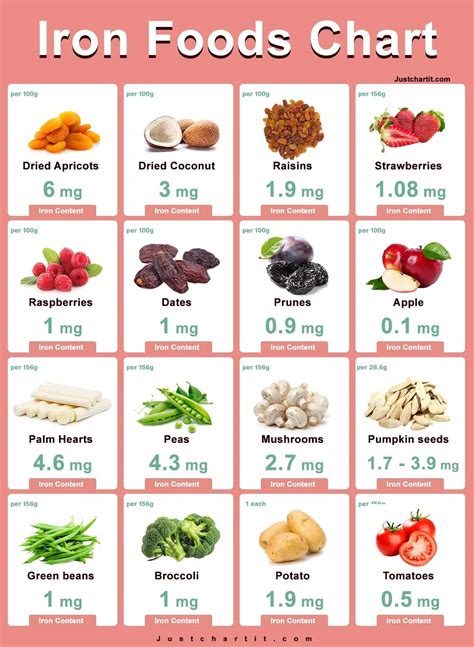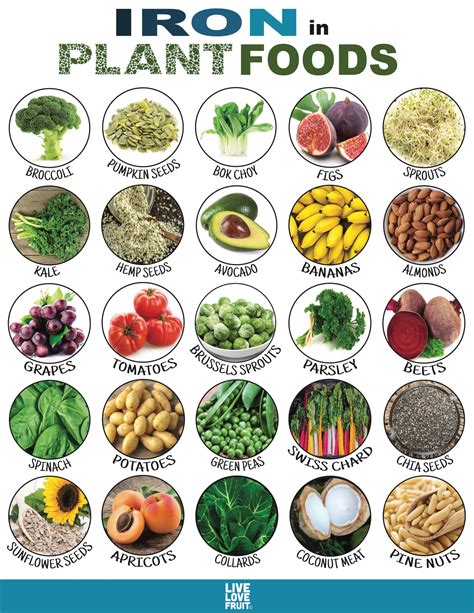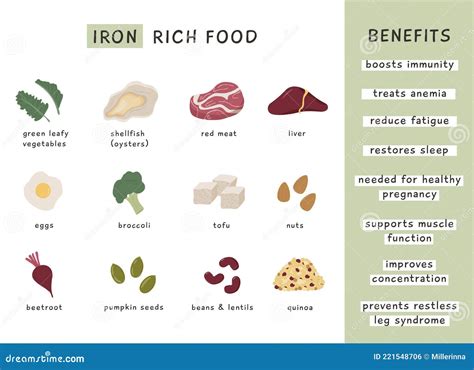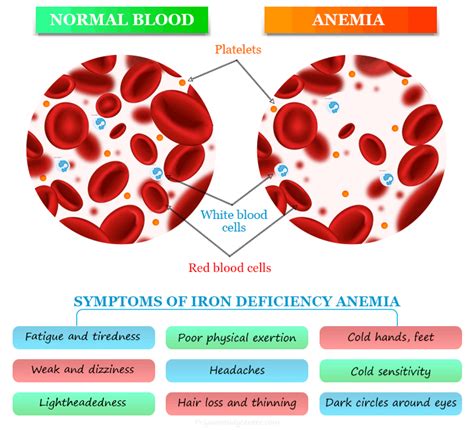Intro
Discover top iron-rich foods, including leafy greens, beans, and red meat, to boost iron intake and prevent deficiency, exploring various dietary sources and nutrition benefits.
Iron is an essential nutrient that plays a critical role in various bodily functions, including the production of red blood cells, the transportation of oxygen, and the maintenance of healthy skin, hair, and nails. Iron deficiency is a common nutritional disorder that can lead to anemia, fatigue, and other health problems. Fortunately, there are many iron-rich foods that can help individuals meet their daily iron needs. In this article, we will explore the highest iron-rich foods, their benefits, and how to incorporate them into a healthy diet.
Iron is a vital mineral that is necessary for the production of hemoglobin, a protein in red blood cells that carries oxygen to different parts of the body. Without enough iron, the body may not be able to produce enough hemoglobin, leading to iron deficiency anemia. This condition can cause symptoms such as fatigue, weakness, pale skin, and shortness of breath. Iron deficiency anemia is a common health problem that affects millions of people worldwide, particularly women of childbearing age, pregnant women, and young children.
The recommended daily intake of iron varies based on age, sex, and other factors. Generally, adult men need about 8 milligrams of iron per day, while adult women need about 18 milligrams per day. Pregnant women need about 27 milligrams of iron per day, while breastfeeding women need about 9 milligrams per day. It is essential to consume enough iron-rich foods to meet these daily needs and prevent iron deficiency anemia. In addition to iron supplements, there are many foods that are rich in iron and can help individuals meet their daily iron needs.
Highest Iron Rich Foods

Red Meat
Red meat is one of the richest sources of iron, particularly heme iron. Heme iron is more easily absorbed by the body than non-heme iron found in plant-based foods. Some of the highest iron-rich red meats include: * Beef: 3-4 milligrams of iron per 3-ounce serving * Lamb: 3-4 milligrams of iron per 3-ounce serving * Pork: 2-3 milligrams of iron per 3-ounce serving Red meat is also a good source of other essential nutrients, such as protein, zinc, and B vitamins.Iron Rich Plant-Based Foods

Legumes
Legumes, such as beans, lentils, and peas, are some of the richest sources of iron in plant-based foods. They are also high in protein, fiber, and other essential nutrients. Some of the highest iron-rich legumes include: * Chickpeas: 4-5 milligrams of iron per 1 cup cooked * Black beans: 3-4 milligrams of iron per 1 cup cooked * Kidney beans: 3-4 milligrams of iron per 1 cup cooked Legumes are also low in calories and rich in fiber, making them an excellent addition to a weight loss diet.Fortified Foods

Nuts and Seeds
Nuts and seeds are also good sources of iron, particularly pumpkin seeds, sesame seeds, and sunflower seeds. Some of the highest iron-rich nuts and seeds include: * Pumpkin seeds: 4-5 milligrams of iron per 1/4 cup * Sesame seeds: 3-4 milligrams of iron per 1/4 cup * Sunflower seeds: 2-3 milligrams of iron per 1/4 cup Nuts and seeds are also rich in healthy fats, protein, and fiber, making them an excellent snack or addition to meals.Benefits of Iron Rich Foods

Increasing Iron Absorption
To increase iron absorption from foods, it is essential to consume foods that are rich in vitamin C, such as citrus fruits, bell peppers, and tomatoes. Vitamin C can increase iron absorption by up to 80%. Additionally, cooking in cast-iron cookware can also increase iron intake, particularly for individuals who have a restricted diet or have trouble absorbing iron from whole foods.Iron Deficiency Anemia

Symptoms of Iron Deficiency Anemia
Some of the common symptoms of iron deficiency anemia include: * Fatigue and weakness * Pale skin * Shortness of breath * Headaches * Dizziness * Cold hands and feet If left untreated, iron deficiency anemia can lead to more severe health problems, such as heart problems, poor pregnancy outcomes, and impaired cognitive function.Prevention and Treatment

Iron Supplements
Iron supplements can be an effective way to increase iron intake, particularly for individuals who have a restricted diet or have trouble absorbing iron from whole foods. However, it is essential to consult with a healthcare professional before taking iron supplements, as excessive iron intake can be toxic.What are the symptoms of iron deficiency anemia?
+The symptoms of iron deficiency anemia include fatigue, weakness, pale skin, shortness of breath, headaches, dizziness, and cold hands and feet.
What are the highest iron-rich foods?
+The highest iron-rich foods include red meat, poultry, fish, beans, lentils, and fortified cereals.
How can I increase iron absorption from foods?
+Consuming foods that are rich in vitamin C, such as citrus fruits, bell peppers, and tomatoes, can increase iron absorption by up to 80%.
In conclusion, incorporating iron-rich foods into your diet can have numerous health benefits, from reducing the risk of iron deficiency anemia to supporting healthy skin, hair, and nails. By consuming a variety of iron-rich foods, including red meat, poultry, fish, beans, lentils, and fortified cereals, and addressing underlying causes of iron deficiency, individuals can help prevent and treat iron deficiency anemia. We encourage you to share this article with others, and to comment below with any questions or concerns you may have about iron-rich foods. By working together, we can promote healthy eating habits and reduce the risk of iron deficiency anemia.
